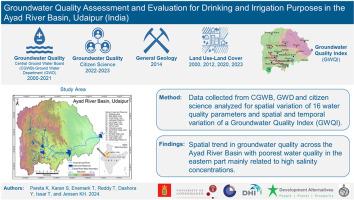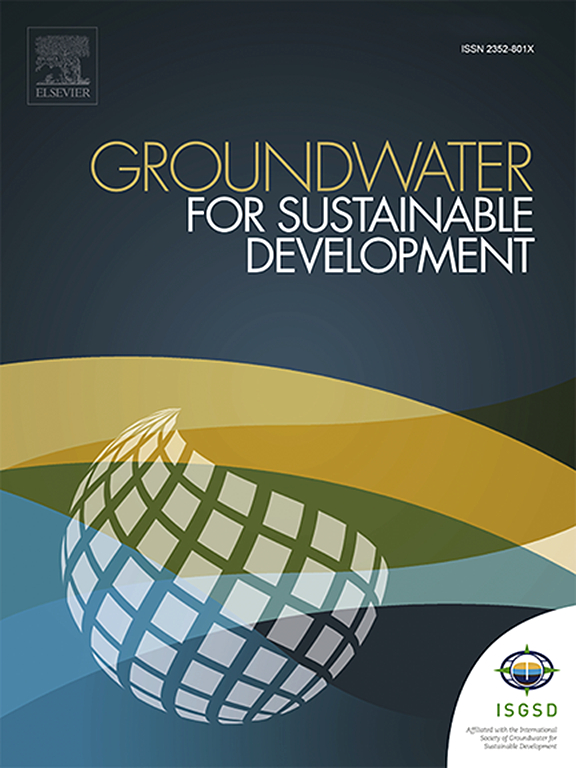Groundwater quality assessment for drinking and irrigation purposes in the Ayad river basin, Udaipur (India)
IF 4.9
Q2 ENGINEERING, ENVIRONMENTAL
引用次数: 0
Abstract
Globally, about 5.25 billion people depend on groundwater for their water needs. However, groundwater quality significantly impacts human health and agriculture, influenced by factors such as land use, waste seepage, soil properties, and geological settings. In Rajasthan, the primary groundwater quality issues involve fluoride, nitrate, chloride, and calcium. This study addresses the gap in the understanding of the spatial and temporal variations of these contaminants and how the variations are linked to geology and land use. The basis for the analysis is data spanning 2000 to 2021from the Ground Water Department (GWD), the Central Ground Water Board (CGWB), and citizen science data from 2022 to 2023, focusing on the Ayad River Basin. The research aims to evaluate groundwater quality for drinking and irrigation by assessing physico-chemical parameters and using the Weighted Arithmetic Water Quality Index (WAWQI) method to calculate the Groundwater Quality Index (GWQI) from 2000 to 2023. The findings suggest a decreasing GWQI trend from west to east in the basin, with good groundwater quality (GWQI below 50) in the southern regions near the cities Umarda, Ramgiri, Undri, and Hariyab. The highest index values were near Bhoyana, Khemli, and Sisarma. The results of the salinity hazard test showed that salinity is a major issue in the eastern part of the basin. Though the groundwater is notably hard, a comprehensive analysis of various parameters nevertheless suggested its suitability for irrigation purposes. These results provide new insights in the quality of the groundwater resources in the Ayad River basin and valuable insights for policymakers and for decision-makers to develop strategies to preserve the groundwater quality.

印度乌代布尔 Ayad 河流域用于饮用和灌溉的地下水质量评估
全球约有 52.5 亿人的用水需求依赖地下水。然而,受土地利用、废物渗漏、土壤特性和地质环境等因素的影响,地下水质量对人类健康和农业产生了重大影响。在拉贾斯坦邦,主要的地下水水质问题涉及氟化物、硝酸盐、氯化物和钙。这项研究弥补了人们对这些污染物的时空变化以及这些变化如何与地质和土地利用相关联的认识上的空白。分析的基础是地下水部 (GWD) 和中央地下水委员会 (CGWB) 2000 年至 2021 年的数据,以及 2022 年至 2023 年的公民科学数据,重点是阿亚德河流域。研究旨在通过评估物理化学参数和使用加权算术水质指数(WAWQI)方法计算 2000 年至 2023 年的地下水质量指数(GWQI),从而评估饮用水和灌溉用地下水的质量。研究结果表明,流域内的地下水质量指数自西向东呈下降趋势,南部地区靠近 Umarda、Ramgiri、Undri 和 Hariyab 等城市的地下水质量较好(地下水质量指数低于 50)。指数值最高的是博亚纳、克姆利和西萨玛附近。盐度危害测试结果表明,盐度是盆地东部的一个主要问题。虽然地下水明显偏硬,但对各种参数的综合分析表明,地下水适合灌溉。这些结果为了解阿亚德河流域地下水资源的质量提供了新的视角,也为政策制定者和决策者制定保护地下水质量的战略提供了宝贵的见解。
本文章由计算机程序翻译,如有差异,请以英文原文为准。
求助全文
约1分钟内获得全文
求助全文
来源期刊

Groundwater for Sustainable Development
Social Sciences-Geography, Planning and Development
CiteScore
11.50
自引率
10.20%
发文量
152
期刊介绍:
Groundwater for Sustainable Development is directed to different stakeholders and professionals, including government and non-governmental organizations, international funding agencies, universities, public water institutions, public health and other public/private sector professionals, and other relevant institutions. It is aimed at professionals, academics and students in the fields of disciplines such as: groundwater and its connection to surface hydrology and environment, soil sciences, engineering, ecology, microbiology, atmospheric sciences, analytical chemistry, hydro-engineering, water technology, environmental ethics, economics, public health, policy, as well as social sciences, legal disciplines, or any other area connected with water issues. The objectives of this journal are to facilitate: • The improvement of effective and sustainable management of water resources across the globe. • The improvement of human access to groundwater resources in adequate quantity and good quality. • The meeting of the increasing demand for drinking and irrigation water needed for food security to contribute to a social and economically sound human development. • The creation of a global inter- and multidisciplinary platform and forum to improve our understanding of groundwater resources and to advocate their effective and sustainable management and protection against contamination. • Interdisciplinary information exchange and to stimulate scientific research in the fields of groundwater related sciences and social and health sciences required to achieve the United Nations Millennium Development Goals for sustainable development.
 求助内容:
求助内容: 应助结果提醒方式:
应助结果提醒方式:


